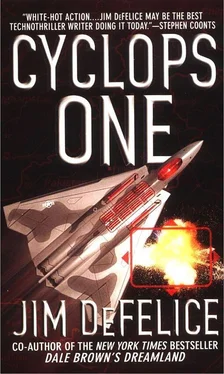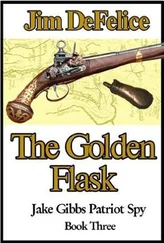He’d been kept from the bases where the Su-27s and Su-30s were, and hadn’t seen a MiG. When he’d come as an assistant to a congressional party a year before, the Indians had eagerly shown off the aircraft. Admittedly, they’d emphasized their defensive abilities, and talked quite a bit about how much easier life would be if they could only purchase F-15s, but still, the difference now was obvious. He’d asked to see one of their Israeli-built Phalcon radar planes but had been told that the aircraft were out of service for maintenance, a fact that he knew was a lie.
This place — a landing strip with no helicopters and no access roads. They were obviously parking him here for the duration.
McIntyre followed his laconic captain toward the low cloud, which soon came into focus as a building. He was not unsympathetic to the Indians; they had their own priorities and concerns, he knew, and in some ways their fierce attitude toward their northern neighbors were justified by history, both recent and ancient. But sympathy wasn’t why he was here.
He was a little late calling Blitz. He hoped his minder would leave him alone in the john so he could make the call.
* * *
Captain Jalil had made his decision as soon as the American stumbled from the helicopter. The colonel had left the option up to him, saying any contingency could be covered.
The man’s ineptness, however, seemed too much an opportunity to let pass. The Americans would be sympathetic when they learned that one of their own men was killed during an inspection of the border area; it would prove to them finally where the danger really lay.
The buzz of the helicopters approaching removed any doubts that Jalil might have had. The captain stopped in front of the empty barracks room and pushed the door open. “You will leave your bag here,” he told McIntyre.
“Looks like a monastery,” said the American. No longer rubbing his eye, he sauntered inside, walking the way all Americans walked: as if he were a great prince visiting part of a far-flung empire. “No locks, huh?”
“There are no need for locks here,” said Jalil. “Come.”
“You know what, I think I’m going to take a nap before dinner, if that’s okay,” said McIntyre. “And I still have to hit the john.”
“No,” said Jalil.
“No?”
Jalil smiled at the American’s surprise. They were not used to being contradicted.
“I believe you’d like to see the helicopters that are arriving,” he told him.
“Maybe later.”
Jalil reached to his holster and pulled out his gun. “Now would be a much better time, Mr. McIntyre.”
Timmy double-checked his position as they came over the border, accelerating to stay on the dotted line the computer provided. The flight indicators were all in the green; every system aboard the aircraft was working the way the manuals said it should. Timmy’s aircraft could have been used to benchmark the fleet.
Which meant everything was boring as shit. Timmy had no doubt they’d nail those suckers if they came up, but he did seriously doubt they’d make their play. The intel people were always — always — overaggressive. They never saw one threat where they could imagine three or four.
More than likely, they’d be orbiting up here for twelve hours straight, back and forth, twiddling their thumbs. He was already feeling a little tired.
Wait until tomorrow, he thought. He kicked himself for not bringing the MP3 jukebox. He’d left it on the bench when Howe saw it and frowned. Mandatory flight equipment from now on.
The colonel had always been the serious type. He was a good pilot, a good leader — a warfighter with scalps on his belt. But serious, very serious.
Losing Cyclops One and Bird Two had hit him pretty hard. He’d been hung up on York; that was obvious.
Pretty quiet about it. Timmy didn’t figure she was a traitor — they’d probably find her and the others smacked against a mountain any day now — but it still was a lot of shit to take.
Keep him awake, though. The pilot clicked the computer to look at his fuel matrix, then put his eyes back on the synthetic view hologram, set at max magnification.
* * *
Howe was just reaching the end of the patrol area when the radar picked up two contacts coming hot out of the north, about 122 miles away. Relatively small and moving fast, the two aircraft were either F-16s or Super-7s. Built with Chinese help, the S-7s were multipurpose fighters roughly comparable to early-model F-16s.
The computer placed the two contacts in the far end of the outer circle in the main tactical display, too far away to show on the HUD hologram. There were three circles, which represented a hierarchy of threats: Anything in the outer ring could be tracked by the F/A-22V, but was not yet close enough to be targeted; the middle ring represented aircraft that could be targeted without detection; the inner ring or bull’s-eye represented aircraft whose sensors were definitely capable of seeing the F/A-22V, though of course combat conditions (and active and passive jammers) might prevent the enemy from actually acquiring or locking on the plane.
“Bogeys,” Howe told his wingman.
“Yeah,” said Timmy. The contacts had been shared through the IFDL and appeared simultaneously on the displays of both aircraft. Nonetheless, standard procedure called for the pilots to alert each other to the new contacts, maintaining situation awareness.
“Turning,” said Howe.
“Two,” acknowledged Timmy.
The Pakistani planes were still flying in a straight line south toward the border. It was possible they were intending to cross over and take out the Indian AEW plane, though much more likely they were meant either as an answer to its launch or were even oblivious to it and flying a training mission.
The Velociraptor’s sensors sniffed out a burst of energy that matched the signature of a Phazotron radar from the airplanes. That allowed the system to positively ID the planes as S-7s and gave the artificial intelligence-based tactics section something to work with as it presented its pilot with a variety of options for attack.
They were roughly fifteen minutes away from an intercept, unless they went to afterburners, and even then they probably wouldn’t be able to find the F/A-22Vs unless they had a way to home in on the radars.
“They don’t see us,” said Timmy.
“No, they don’t.”
“What do we do if they find the helicopters?”
“Let them shoot them down,” said Howe. His orders had been explicit on that point. It was far better for the Pakistanis to do the heavy lifting on their own, without U.S. help.
“I’m getting a contact south,” said Timmy, “in grid alpha-alpha-two. Fighters. MiG-29s. Four of them.”
“I see it,” said Howe.
“Four more aircraft. This may be it.”
“No, it’s a diversion,” said Howe. “It’s out of the target area. Stay on track.”
“Looks real to me: Sukhoi-30s, four of them — eight! Attack package, and these motherfuckers are moving.”
There was a bright side to all of this, McIntyre thought to himself as the helicopter hurled itself through the looming shadows of the mountains: He had done his job very, very well. He now knew exactly what the Indians were up to.
Well, not exactly. He assumed they were going after a radar site, though there were any number of other possibilities. He guessed he’d find out fairly soon, however.
Unless they decided to dump him out the door of the helicopter before they got to where they were going. That might not even be such a terrible option, since they weren’t all that high — maybe only six or seven feet over the ground. If they threw him out now, it would be more like falling from a train than an airplane.
Читать дальше












